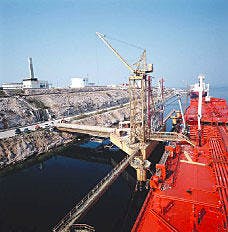By year end, Russian crude oil may be moving out of a deepwater terminal on the Mediterranean Sea into world export markets, thanks to a tariff accord ratified in late 2001 by Ukraine.
Russian Urals blend would flow 1,987 miles via the Druzhba and Adria pipeline systems west to the Croatian port of Omisalj, the final link being a newly reversed 110.5 mile, 36-in. line from the inland terminal at Sisak, Croatia.
At Omisalj, the oil would be loaded into tankers up to 500,000 dwt (ultra large crude carriers, or ULCCs) for tran sit through the Adriatic, Ionian, and Mediterranean seas to markets in the US and Asia (map).
The agreement and its implications were reported earlier this year by the FSU Pipeline Advisory Service of the Centre for Global Energy Studies, London, citing the Russian publication Commersant.
Ukraine's acceptance of a tariff matching what other countries receive opens the way for reversal of the Croatian pipeline segment. At present, the link between the port and the terminal flows imported crude east to Sisak. Russia's AK Transneft and Yukos Oil Co., said CGES, are both anxious to have the projected completed by yearend.
Tariff pact
Ukraine's parliament ratified a tariff of 64¢/tonne/100 km for Russian oil crossing its territory en route to Omisalj.
Russian oil companies had seen this as the last major obstacle for the pipeline project that will be the final link into the port.
In April 2000, Ukrainian pipeline operator Druzhba had agreed to cut its transit tariff to 64¢ from 72¢/tonne/100 km, bringing it in line with Belarus, Slovakia, Hungary, and Croatia, the other countries through which the route passes. But Ukraine's parliament held up approval until late last year.
Estimated cost for reversing the pipeline and related construction is $120 million, according to CGES. The plan is for the entire pipeline eventually to have a capacity of 15 million tonnes/year (tpy; about 300,000 b/d) of Russian crude.
Another existing pipeline, from Hungary's 161,000-b/d Szazhalombatta refinery to the Sisak terminal, already can carry oil in both directions and has been used to carry Russian oil to Sisak for further deliveries to regional refineries.
Reversing the existing line between Sisak and Omisalj means that the route will be able to carry Russian oil for export as well as about 24 million tpy (480,000 b/d) of oil imported from other sources for use in regional refineries.
Port terminal; Bosporus
The Omisalj oil terminal has two berths (photograph), with water depths alongside of 30 m, capable of handling vessels up to 500,000 dwt. CGES said land is available to extend the port facilities by adding two berths (one with the same capacity as the existing two and the other capable of handling vessels of 150,000 dwt) and by building crude oil storage tanks to take storage capacity to 1.5 million cu m from the present 680,000 cu m.
With the 36-in. line reversed to the Omisalj, the entire pipeline route would handle 5 million tpy of Russian oil in the first full year of operation, which Transneft and Croatia's pipeline company Jadranski Naftovod dd, Zagreb (Janaf), hope will be in 2003, said CGES and Janaf. This level would rise to 10 million tpy after 5 years and 15 million tpy after 10 years (table).
CGES said use of larger tankers (VLCCs and ULCCs) to carry Russian crude oil would make exports to the US and to markets in Asia-Pacific much more economic than at present. Shipments from Russia's main southern port of Novorossiysk are limited to 150,000-dwt vessels (Suezmax size and smaller) by restrictions on traffic through Turkey's Bosporus Straits. Development of the Druzhba-Adria pipeline system will be the first complete bypass of the straits.
In theory at least, CGES said, a Druzhba-Adria connection could also carry Caspian Sea-area crude around the Bosporus, taking oil from Ukraine's Odessa-Brody pipeline.
This would require, however, either a quality bank or the batching of crudes of differing qualities to preserve their values.
Furthermore, said CGES, Yukos, the Russian company most actively involved in the Druzhba-Adria project, plans a large increase in its oil production.
It rose by more than 17% in 2001 to 58.1 million tonnes, and Yukos plans to increase it to 68-70 million tonnes this year. Virtually all of this additional oil will be exported, said CGES, leaving Yukos searching for spare pipeline capacity.
The Druzhba-Adria export system makes sales of Russian oil to the US "much more interesting than they have been in the past," said CGES, when restrictions on the size of vessels loading at Russia's Black Sea and Baltic ports have undermined the economics of transatlantic trade.
A tariff of 64¢/tonne/100 km along the entire 3,200-km route from Samara to Omisalj translates into a transportation cost of $2.80/bbl to deliver the oil to the Adriatic, said CGES, making transatlantic delivery of Russian crude on a large scale realistic for the first time.





